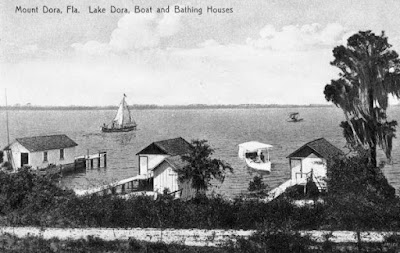Mr.
Brittain Goes to Washington
1910 Tavares & Gulf Railroad photo above courtesy Florida Memory
A
CitrusLAND 2022 Happy New Year Blog
By
Richard Lee Cronin
Happy
New Year!
My New Year’s Resolution for 2022 is to continue
writing about intriguing Central Floridians, and so, I might as well get
started now by telling of Walter M. Brittain of Washington, DC, a
gentleman having connections with Orlando, Lake County, and the Tavares
& Gulf Railroad.
Fans of local history and railroad history, I believe,
will find Walter Brittain quite fascinating, for he is characteristic of many
of this region’s earliest forerunners. An Orlando land developer and Clermont
railroad executive, Brittain came south to Florida in the early 1900s with all
the right intentions. But like many who came before and after him, Walter Myron
Brittain soon vanished. Brittain’s first central Florida job title was Vice
President & General Manager of Tavares & Gulf Railroad, but
like that of his T&G predecessor, he lived in downtown Orlando – 30 miles east
of Clermont, the railroad’s base of operations at that time.
Before detailing Walter’s local involvement, I should
first mention why I chose him to headline this ‘Happy New Year’ blog. Walter Brittain
and I, it turns out, happen to share a job title. I am honored to begin serving
today as Vice President of Education & Public Relations for Central
Florida Railroad Historical Society, parent organization of central Florida’s
premier museum, the Central Florida Railroad Museum at Winter Garden.
My new position with the museum fits perfectly with what
I enjoy doing most – researching and writing about how the earliest days of central
Florida’s history corresponds with America’s remarkable history.
One case in point? Walter M.
Brittain!
I have been researching and preparing for a
presentation on January 31st to the Central Florida Council for
Florida House. Long fascinated by the little-known roles District of
Columbians had played in the 1870s and 1880s in developing Florida’s Citrus
Belt, I decided my talk would be about many of those noteworthy individuals. By
the way, were you aware that our State of Florida is the only State to have an
Embassy at Washington, DC?
The invite to speak to this outstanding organization, I decided, was a perfect opportunity to talk, for the first time ever, about CitrusLAND, DC.
Become a member
of the CFRR! Email me for details!
Now then, back to that FRC Order. The T&G
Railroad failed to meet conditions as set out by the 1908 order, but
the reason for not complying was likely not due to insubordination by Brittain.
The unstable financial situation of the railroad was more likely the cause. Walter
M. Brittain was still the Vice President & General Manager in 1910, but by
1912, he and the railroad had parted ways. Brittain, as did most every central
Floridian of that time, tried his luck as a land developer.
Charles A. Carpenter, also a resident of Orlando, assumed management of the T&G in 1912.
Walter Myron Brittain,
born May 23,1878 at Washington DC, died 12 December 1944 at DC. A graduate of
Georgetown University, Walter Brittain first worked for a DC steam railroad,
but by 1903 was working at Richmond, VA, employed with the Seaboard Air Line
Railroad. That same year, the head of the T&G Railroad at Orlando,
Florida died, so W. M. Brittain came south to central Florida to fill that
vacancy.
While living at Orlando, Walter M. Brittain, in
addition to managing the T&G, partnered with well-known Orlandoan Samuel
Y. Way. The two developed residential lots at Lake Leora, the body of water described in my book, Orlando Lakes: Homesteaders & Namesakes, as Park Lake today, off East Colonial Drive.
Brittain & Way Real Estate Company was located, in 1912, at 13 S. Orange Avenue. Walter, and wife, Ethel Florence (Thompson), lived at the Brittain & Way development, but their specific parcel has since made way for widening of Colonial Drive.
Walter left Central Florida to accept a position with
the Pennsylvania Railroad at Pittsburgh, PA. He eventually returned to
Washington, DC, where in 1944, while working as an employee of the Federal
Housing Administration, Walter Myron Brittain died at the age of 66.
Brittain’s story as it pertains to central Florida
history is not at all unusual. Many a venturesome sole migrated from the North hoping
to make a difference, only to find challenges which seemed insurmountable – encounters
which then sent them packing.
As early as 1873, correspondent Will Wallace Harney of
Pine Castle told of the one ingredient each and every newcomer to Central
Florida needed most: “Without pluck and courage,” Harney wrote shortly after
his own arrival at Orange County, “he cannot live in Florida”. I would argue
though that it took more than mere courage for those who came to this land
during the first hundred years after Statehood.
One had to be resolute that, no matter how often fate knocked
them down, as it did so often, our central Floridian forefathers and
foremothers needed the endurance to get back up on their feet and prepare to
face the next insurmountable challenge head on.


























